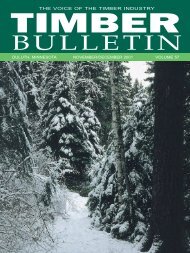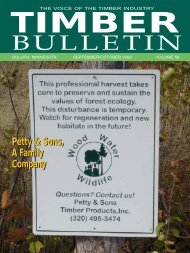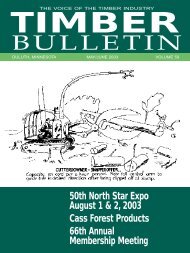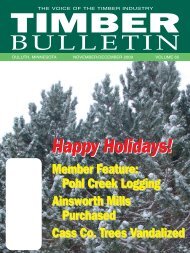Timber Bulletin Nov/Dec - Minnesota Forest Industries
Timber Bulletin Nov/Dec - Minnesota Forest Industries
Timber Bulletin Nov/Dec - Minnesota Forest Industries
- No tags were found...
You also want an ePaper? Increase the reach of your titles
YUMPU automatically turns print PDFs into web optimized ePapers that Google loves.
THE VOICE OF THE TIMBER INDUSTRYTIMBERBULLETINDULUTH, MINNESOTA NOVEMBER/DECEMBER 2010 VOLUME 65HappyHolidays
THE VOICE OF THE TIMBER INDUSTRYTIMBERB U L L E T I NIN THIS ISSUETurning Point – Greg Cook Logging.................8_________________________________________________________________________________CSAand <strong>Forest</strong> Products Trucking...............14_________________________________________________________________________________<strong>Timber</strong> Talk........................................................18_________________________________________________________________________________Lessons from Losses.....................................22_________________________________________________________________________________On the Markets.............................................25_________________________________________________________________________________Loggers of the Past .......................................26_________________________________________________________________________________Classifieds ...................................................30_________________________________________________________________________________Advertisers Index.......................................30_________________________________________________________________________________814Volume 65<strong>Nov</strong>ember/<strong>Dec</strong>ember 2010Duluth, <strong>Minnesota</strong>TIMBER PRODUCERSASSOCIATIONPresidentMIKE WARRENPast PresidentMIKE RIEGER1st Vice PresidentKIT HASBARGEN2nd Vice PresidentSCOTT PITTACKSecretary/TreasurerDAVE BERTHIAUMEEditor-in-ChiefWAYNE E. BRANDTGraphic Design, Editorial and Mechanical ProductionSTEWART-TAYLOR PRINTING<strong>Minnesota</strong><strong>Timber</strong> ProducersAssociationON THE COVEREarly season snow means a whiteChristmas for 2010 in <strong>Minnesota</strong>ʼsforest.The <strong>Timber</strong> <strong>Bulletin</strong> is published six times annually,in February, April, June, August, October and<strong>Dec</strong>ember by the <strong>Minnesota</strong> <strong>Timber</strong> ProducersAssociation, located at 903 Medical Arts Bldg.,324 W. Superior St., Duluth, Minn. <strong>Minnesota</strong><strong>Timber</strong> Producers Association members receivethe <strong>Timber</strong> <strong>Bulletin</strong> at an annual subscription rateof $25 which is included in their membership dues.Periodicals postage paid in Duluth, <strong>Minnesota</strong>.Advertising rates and data on request. The viewsexpressed in the <strong>Timber</strong> <strong>Bulletin</strong> do not necessarilyreflect the views or opinions of the <strong>Minnesota</strong><strong>Timber</strong> Producers Association.Postmaster: Please send address correctionsto TIMBER BULLETIN, <strong>Minnesota</strong> <strong>Timber</strong>Producers Association, 903 Medical Arts Bldg.,324 W. Superior St., Duluth, <strong>Minnesota</strong> 55802,Phone 218-722-5013.Issn: 10973532 – USPS: 0162082226No articles may be reprinted without written permissionfrom the <strong>Minnesota</strong> <strong>Timber</strong> Producers Association.<strong>Timber</strong> <strong>Bulletin</strong> <strong>Nov</strong>ember/<strong>Dec</strong>ember 20103
Wow! The dust has finallysettled on the election and youneed to scorecard to keep track ofall of the new players. FormerSenator Mark Dayton was thevictor in the Gubernatorial race.He has a long track record ofsupporting forestry. This goes backto when he was EconomicDevelopment Commissioner forGovernor Rudy Perpich. Mark wasdeeply involved in the PerpichAdministration's successful effortsto recruit forest productscompanies to invest in <strong>Minnesota</strong>.These efforts resulted in over $4billion in capital investments innew and expanded plants. ThePerpich view, and I believe that thiswill be Governor Dayton's view,was that we have well managedforests inExecutive VicePresident’sColumnour state,professionalloggers,responsiblecompaniesand byutilizingthese assets canchart a strongereconomic future forour state.When he servedin the U.S. SenateMark was a strongsupporter of the U.S. <strong>Forest</strong> Servicetimber sale program and went tobat for us many times. He evenwent so far as to personally file anamicus brief in support of formerSenator Larry Craig's lawsuit onthe old roadless rule. We lookforward to working with GovernorDayton.Both houses of our legislaturechanged hands with Republicanstaking over. This is historic in theSenate where Republicans have notbeen in control since partydesignation was added to the ballotnearly forty years ago. NoRepublican Senator has served inthat body's majority nor have anyof them chaired a committee.Republicans had the majority in theHouse of Representatives asrecently as four years ago so theyhave a number of experiencedleaders.The new Speaker of the Housewill be Kurt Zellers, a formerstaffer to Senator Rod Grams whohas a good head on his shoulders.The new Senate Majority Leaderwill be Amy Koch who is creditedwith engineering their ascension tomajority status. These two newleaders have been very clear intheir priorities: the economy, jobs,the state budget and anything elsethat makes it easier to do businessin <strong>Minnesota</strong>. This should bodewell for our issues.Both bodies have reorganizedand streamlined their committeestructures. Most significantly thefinance and policy committees havebeen merged. The HouseEnvironment and NaturalResources Finance and PolicyCommittee will be led byRepresentative Dennis McNamara.He ran a nursery and landscapebusiness for many years and hassupported forestry. The SenateCommittee will be chaired by BillIngebrigtson from Alexandria. Hehas been solid on forestry issuesand served four terms as theDouglas County Sheriff beforemoving on to the Senate.With more than seventy newmembers, the legislature will be aninteresting place for the next twoyears. I won't go out on a limb andmake any predictions on our issuesas we work with new members andleadership.And, don't forget that with thecompletion of the decennial censusall of the legislative districtboundaries will be redrawn and theentire House and Senate will be upfor election again in two years. After a <strong>Nov</strong>ember where wewere playing golf winter hit hardmid-month. With a lot of snow ontop of unfrozen ground in manyareas it looks like it will be astruggle. One thing that shouldn'tbe a struggle is operating safely.We are closing out what looks likeanother strong, safe year in ourLUA workers compensationprogram. We can struggle withweather, equipment, contracts andmarkets but let's not struggle to besafe. Let's make it a priority everyday this winter. Darla Lenz has been named asthe new Supervisor on theChippewa National <strong>Forest</strong>. Ms.Lenz is currently serving as aDistrict Ranger on the OttawaNational <strong>Forest</strong> in Ontonagon,Mich. We look forward to workingwith her when she assumes hernew post in 2011. A pioneer in the history of TPAleft us when Donna Korhonenrecently passed away. Donna wasthe first woman to serve on theTPA Board of Directors. She hadone of the all-time great quoteswhen asked if she was really alogger she responded "I may notrun a power saw but I run alogging business". I rememberseeing Donna at a timber auctionnot too long after her husband Leshad passed away. She showed mea list of the sales that she wasinterested in that day. She had allthe bid increments for each of thesesales laid out in charts with aprominent red line on the chart.She told me the red line marked thepoint at which she calculated shecould not make a profit on the saleand would stop bidding. Donnawas always very sharp, a credit toher family and our industry. Oursympathy goes out to her family. As we close out another year Iwant to thank all of our TPAmembers for your support andfriendship this year. You make itfun and worthwhile to come towork every day. If there's a betterorganization I haven't heard of it. I want to thank our staff for thegreat job that they do. Jane Abel,Ray Higgins and Tim O'Hara atMFI are the best!Thank you to all of the dedicatedpeople in the county landdepartments, DNR and US <strong>Forest</strong>Service. We may pick and kick,huff and snort but we appreciatewhat you do every day.Enjoy the holidays with familyand friends. And, let's all take timeto count our blessings – every day.6 <strong>Timber</strong> <strong>Bulletin</strong> <strong>Nov</strong>ember/<strong>Dec</strong>ember 2010
Member Feature...L-R: Carl Bleiler, Clinton Cook, and Jason Roach of Greg Cook Logging.Turning PointClinton Cook and his colleagues at GregCook Logging faced a difficult decisionand the result wound up paying off.by Ray HigginsIt was summer 2006. Thirty-yearoldClinton Cook had been helpingout with this dad’s loggingcompany since he was in the 8thgrade. But a couple of monthsearlier, Clinton found himself incharge of the company and facing awhale of a decision. He didn’tknow it at the time, but an industrydownturn was right around thecorner and the outcome of thedecision would play a major role inwhether the company survived.“That decision,” Cook says, “wasa turning point. We were verylucky.”His father, Greg Cook, hadstarted the company in the early1970s. He’d been a hockey-playingTwin Cities kid, even playing in a8 <strong>Timber</strong> <strong>Bulletin</strong> <strong>Nov</strong>ember/<strong>Dec</strong>ember 2010
junior league and centering a linewith Jack and Jeff Carlson, each ofwhom would become famous –Jack as an enforcer with the NHL’s<strong>Minnesota</strong> North Stars, and Jeff asone of the Hanson Brothers in themovie classic “Slapshot.”One summer, Greg took a jobworking in the Bigfork area –where his grandfather had land –for logger Dick Jensen. Greg lovedthe work, the independence, andthe opportunity to spend time inthe woods. Despite the fact that atryout with the Detroit Red Wingswas in the works, he quit hockeyand ultimately started Greg CookLogging.Greg also started a family, andwhen his son Clinton made it to theeighth grade, he began helping outwhere possible.“I was running cable skidder anda chainsaw,” Clinton says. “Weprobably only had three guys.”“We had two skidders, a Bobcatbuncher, and three trucks at thattime” says longtime employeeJason Roach. “There wasn’t muchequipment. Very little.”As Clinton grew older, he startedhauling, making wood deliveries,most of the time to one of thePotlatch mills.“I drove truck for four years,” hesays. “I was driving truck while Iwas still a senior in high schoolafter school. I guess I drove two orthree loads in the afternoons. Andthen that summer after I graduated,I started driving truck full time.”The business began to grow.Clinton transitioned from haulingto running a Timbco feller-buncher.And Greg began adding equipmentand employees, so that by the time2006 rolled around, the companyhad four crews, two withconventional equipment and twowith cut-to-length.But in early 2006 Greg decided tomake a change, finding a calling topreach. So at the age of 56, heretired from logging, entered theministry, and turned the businessover to Clinton.“When Dad retired, he wasdone,” Clinton says.“He kind of turned the switch offand that was it for Greg,” sayscompany forester Carl Bleiler.Greg left Clinton with asuccessful business built onhonesty and hard work.Fred Pitzen is a 16-year employee of Greg Cook Logging and is driving the JohnDeere 748H skidder.“I mean I’ve never known mydad to cheat a soul,” Clinton says.“I remember sales when we werecleaning up loads when I was atruck driver, and I was picking uptwo cords of balsam from one joband going to the next to pick upthree loads. I’m sure there are guyswho would just forget a ticket fromone sale and put the wood theother one, but not my dad. He’dinsist on figuring it out for bothsales.“He always told me, what’s itworth to you to be able to sleep atnight? So why rip someone off andlose sleep over it? He was all abouthonesty and hard work.”<strong>Timber</strong> <strong>Bulletin</strong> <strong>Nov</strong>ember/<strong>Dec</strong>ember 20109
By this time, Potlatch had sold itsoriented strand board mills inCook, Grand Rapids, and Bemidjito Ainsworth, and its Cloquetpaper mill to Sappi. The Cookswere almost exclusively sendingtheir wood to one of the Ainsworthmills. But the opportunity came tosend some wood to Sappi.“Clinton developed arelationship with Sappi,” Bleilersaid, “and it just blossomed fromthere.”That’s when the turning pointcame. During that summer of 2006,Clinton was at the DNR’s Hibbingarea auction at Ironworld and a2000-cord sale in several differentblocks near Giants Ridge wasavailable.“We never looked at it,” Clintonsays. “The ground over there isrocky, but it was summer groundand we needed summer wood, so Ibought it.“It was a tough sale. Nothingspecial about it. We fought itthrough rough rocky terrain, andthen it started raining that month,”he says. “We got it done, though.”The way the summer was goingwith all of the wet weather,Ainsworth was eager to have thewood, but so was Sappi, so Cookhad to decide where to send it.“I remember I asked my dad andour pastor what they thought,”Clinton says. “They both cameback with the same answer: theysaid go for Sappi. From thespiritual end of it, they’re kind ofmy advisers. I asked them and saiddo you think Sappi’s the way to goand they both called me back andsaid yeah and that’s when westarted bringing that wood there.Even in the wet weather, we got thewood in.”What no one could know at thattime was that just a few weeks laterin September, Ainsworth wouldstop production at its three OSBmills, thanks to a global housingcrisis. Ainsworth continued to buywood for a while but the plantswere ultimately shuttered.“I don’t think anyone saw itcoming,” Cook says.But for Cook, the relationshipwith Sappi had been establishedand then solidified by bringing thewood from the Giants Ridge sale toCloquet.“Clinton shipped a lot of woodThis Komatsu PC 220 LC delimber with a Lim-mit 2100 has limbed over 300,000cords but is still going strong, thanks to good maintenance by employees likeoperator Jason Tower.to Sappi when Ainsworth was stillgoing,” Roach says, “and I thinkthat helped a lot. There were stillsome markets with Ainsworth andClinton decided to go with Sappi.And that kind of sealed the deal forus, I think.”Cook’s monthly contract at Sappiwas gradually increased, stemmingthe tide as the Ainsworth millseventually stopped accepting wooddeliveries and closed permanently.Loggers who’d been Ainsworthproducers had to scramble to findnew markets, so having a foot inthe door at Sappi helpedimmensely.“We scratched and clawed forevery market we could find,” hesays. “We were bringing wood toevery small sawmill, anything youcould think of. We got in withPotlatch, thinning some of theirland, to keep our processors busy.It got really competitive at Sappi.They probably had a bunch ofloggers to pick from. I just think itwas our summer wood thatattracted them. Carl workedextremely hard getting us summerwood and that paid off. Ourcontract at Sappi went from 100cords to 200 a month, and then wegot 500 for a month and it grewfrom there. We always filled ourcontract.”But the company wasn’t out ofthe woods just yet. Despite all thescrambling, markets were stillincredibly tight. The housing crisishelped cause the overall economyto suffer. And although stumpageprices had dropped, so were theprices the mills were able to payloggers for their wood.For Cook, it meant makingdifficult decisions. Two of thecompany’s four logging operations– one conventional and one cut-tolength– were parked. Employeehealth insurance was eliminated.And several sales that had beenpurchased were turned back to theDNR, meaning the forfeiture ofover $250,000 in down payments.“I didn’t know if we were goingto make it through those badyears,” Clinton says. “We were along ways behind on equipmentpayments. We had a lot of renegotiatingwith banks,refinancing, and stretching thingsout longer. We turned back allthose sales, and then there werethose sales that were in-between:they were not too expensive to turnback, but you’re cutting them foralmost a break even, so we wentthrough about two years where wewere just cutting for nothing. Justworking. But the whole crewhelped out. I mean everyonecrunched down and worked thatmuch harder.”10 <strong>Timber</strong> <strong>Bulletin</strong> <strong>Nov</strong>ember/<strong>Dec</strong>ember 2010
Through all of the cutbacks,Cook gambled on actuallyexpanding into producing biomass,purchasing a grinder during thesummer of 2007.“I had a crew laid off,” he says,“and four or five semis just sitting,and this biomass talk was gettingbig, so I thought well, we haveeverything we need, we have thetrucks, the skidders, the bunchers,they’re just sitting. All we neededwas the grinder. So a bunch of usdrove down to Arkansas to thelogging show and we ended upgetting a grinder in Little Rock,Ark. We trucked it home and gotin with <strong>Minnesota</strong> Power andLaurentian Energy and got thatcrew back to work, running thegrinder, cleaning up our tops andbuying some tamarack, deadtamarack, any kind of tamarack forwinter and got that crew going forgrinding.”Cook was also able to startthinning pine for Potlatch, puttinga cut-to-length crew back to work,meaning layoffs were minimal.“Most everybody kept working,”Roach says. “We just founddifferent jobs for everybody.”Another lesson learned fromClinton’s father also helped theNow that it’s been harvested and delimbed, this wood waits to be slashed beforeit is hauled to Sappi’s Cloquet mill.company through the difficulttimes.“Something that Gregemphasized on both of us when wewere young, is that the mostimportant thing is to keep yourtrucks rolling and hauling,” Roachsays. “That’s what it comes downto. If your product isn’t gettingdelivered, you’re not making anymoney. So if something breaksthat’s going to alter or affect yourtrucks, you’d better get going soyour trucks can work tomorrow.”The hard work paid off. Thehigher-priced stumpage washarvested, clearing thoseresponsibilities. Markets graduallyimproved, and the new markets thecompany scrambled to securesolidified. And creditors wereunderstanding, allowing Cook to<strong>Timber</strong> <strong>Bulletin</strong> <strong>Nov</strong>ember/<strong>Dec</strong>ember 201011
catch up on payments.“Rich Miska, at AgStar, was ahuge help with our payments,”Cook says. “We got that wood offthe books and now I’d say lastwinter was actually the first winterwe cut stumpage I could actuallymake my payments, and get caughtup.”“In hindsight now I’m glad ithappened that way because itforced me to learn a lot quickly,versus having it easy,” he says.“But I still don’t know how wemade it through it to be honestwith you.”Cook gives much of the creditto his employees, 27 in all acrossthe woods crews, including themen and women who drive the13 company owned trucks. On topof that, a dozen or so truckingowner-operators help haul thetimber.“We have good guys,” Cooksays. “You’ve got to give credit tothem. Carl’s great, Jason’s as goodas it ever gets. He works just ashard as I work. They both do. Hehandles the trucks on his crewpretty much. You have to havegood guys.”Roach is a great example. Abuddy of Clinton’s dating back totheir days together at Bigfork HighSchool, he joined the company in1992.“The pay is good,” Roach says,“but more importantly, Clinton’sfair and honest. I just enjoy it.”Cook can also point to the crewthat’s working not too far away onthis 62-degree <strong>Nov</strong>ember day on a450-cord Cass County sale. Asidefrom Roach, Fred Pitzen drivesskidder and has been with thecompany 16 years – in fact he’sbeen working in the woods sincehe was 9, piece cutting by handwith a horse and dray in the Effiearea – while Clinton’s brother-inlaw,Jason Tower, in the limber, hasbeen here 12 years.“This crew here, they love towork,” Cook says. “For example,Fred slept in the skidder the lasttwo nights because it was a longskid. So he sent the limber off forhome and he skidded until he ranlow on fuel and then he slept in theskidder. In this industry you haveto like it. You have to like to workand like what you’re doing.Because we’ve had employeescome and go, and you can’t reallyblame them, but they’re not cut outfor this.“Plus, this crew’s easy onequipment,” he says. “All of them.That limber looks brand new and ithas 15,000 hours on it? Just thatmachine has limbed over 300,000cords.”“Some don’t want to put in theextra effort,” Roach says. “Somenights turn into 10 or 11 o’clock atnight, working on stuff, whatever’sgot to be done so you can functionthe next day. Certain guys try toget it done and that’s kind of theway it goes, I guess.”“It’s hard on families,” Cooksays. “We’re not home until late.Everybody’s wife deals with that.We’re in hotels a lot of nights, wework away from home, some guysare gone most of the summer.“One of the truckowner/operators who works withus, Jim Wilson, gave us a goodcompliment,” Cook says. “Duringthe downturn, he chose to staytrucking here as an owner/operatorbecause he said if anyone’s goingget through the tough times, I pickyou, because it’s like 40 below at 2in the morning, and your guys areout here working on stuff thatneeds to get going so trucks canhaul the next day. That comesfrom having good people.”The company’s process is suchthat it’s rare that there are morethan a couple of pieces ofequipment on a site at one time,meaning the crews can be spreadout over as many as a dozenlogging jobs.“We’re more of a step-by-stepprocess,” Cook says. “Usually thebuncher’s hopefully a few jobsahead and then the skidder andlimber comes, and then someonecomes in and slashes it and loadstrucks. That way when one guybreaks down everyone else is stillmoving. We’ve done some hotlogging when we’ve needed to, butwhen one guy breaks down theneverybody’s done that way.“One time this summer we had18 different jobs getting hauledfrom in the same week. Eighteendifferent sales had wood on them.”Keeping all of those balls in theair is difficult, but it helps thatCook’s sister, Renee, and his wife,Tracy, help with the books. Plus,Clinton used to try to run thecompany while running a Timbcofeller buncher, but he turned thoseduties over to someone else overthe summer.“I haven’t been bunching asmuch since June,” he says. “Ithought I was doing just finerunning the Timbco and everythingelse, but now that I’m not in it Ican’t believe the difference. I did alot of it from the Timbco with anearpiece going but I’m better offnot in it.”But even with the improvingbusiness conditions, not everythinghas gone smoothly. One of thebusiness’ long-time slasheroperators – and a long time familyfriend – Floyd Cole was killed in aone-car accident while on the wayto work early one morning in July.“They think he swerved to miss adeer, but nobody really knows,”Clinton says. “My mom graduatedhigh school with him and I playedbasketball and graduated with hisson. I used to stay at his housewhen I was a kid. He was a greatemployee, worked hard every day.That’s the worst experience of all ofit, much worse than anythingfinancial, losing an employee,especially one I’ve known all mylife.”But the work continues. Thebirch bolts from this job will go to asawmill in Remer, while the aspenand pulpwood is headed for Sappiand the jack pine bolts to Potlatchin Bemidji. Then the grinder willcome and grind the tops andwhatever doesn’t make 100 inches,to be sold to the power plants orSappi. Cook acknowledges it’sstressful keeping the crewsoperating and the business going,but he loves the independence andflexibility the business provides.Plus, logging is in his blood.“I guess it’s just what I grew upknowing,” he says. “There’s not adull moment, and a lot of creditgoes to my wife for dealing withme on those nights when I’mcrabby.”12 <strong>Timber</strong> <strong>Bulletin</strong> <strong>Nov</strong>ember/<strong>Dec</strong>ember 2010
CSA and <strong>Forest</strong> Products TruckingHow Will Implementation of the Comprehensive SafetyAnalysis Program Affect Wood Supply Chain Management?The <strong>Forest</strong> ResourcesAssociation assembled thefollowing information aboutCSA (formerly known as CSA2010), the new system formonitoring compliance withfederal trucking regulations.The Federal MotorCarrier SafetyAdministration introducesits new “ComprehensiveSafety Analysis” Programthus:“Since the 1970s, Federaland State enforcementagencies, in partnership withmany other stakeholders, haveprogressively reduced the rateof commercial vehicle crashesresulting in injuries orfatalities on our Nation’shighways. As the rate of crashreduction slowed, the FMCSAhas been prompted to take a fresh lookat how the agency evaluates the safetyof motor carriers and drivers and toexplore ways to improve itsmonitoring, evaluation, andintervention processes. ComprehensiveSafety Analysis 2010 (CSA 2010) isthe result. CSA 2010 introduces a newenforcement and compliance model thatallows the FMCSA and its StatePartners to contact more carriersearlier in order to address safetyproblems before crashes occur. Theultimate goal of CSA 2010 is toestablish a new nationwide system formaking the roads safer for motorcarriers and the public alike.”Since the program is new, and isstill in the process ofimplementation, there are manyquestions about how CSA willchange the regulatory, enforcement,and administrative environment inwhich drivers, trucking firms, andtheir customers operate. FRA hasdeveloped this brief document tohelp clarify points about whichconfusion exists.Issue: There are hundreds of new rulesand regulations under CSA.Fact: CSA is not a package of newrules; it’s just a change in how theold rules are enforced. However,because CSA “removes ambiguityfrom existing rules,” the driver orfleet manager may find a new levelof accountability is required. Forexample, many drivers would get awarning when a roadsideinspection revealed a tire treaddepth less than 2/32”. Authority toregulate tire tread depth isn’t new,but under the previous system theinspecting officer had discretion toenforce the overall intent of the law.Under CSA, although the tire treaddepth regulation isn’t new, theenforcement of the regulation haschanged significantly. CSA 2010arranges each section of theapplicable law into discretecategories and assigns a point valueto each violation. The effect is that,although the driver still gets awarning, under CSA 2010 he willalso get 25 points added to his DOTnumber. Once the driveraccumulates more points than hisor her peer group, the interventionprocess begins. However, FMCSAasserts that trucks and drivers thatare in compliance today and passroadside inspections withoutincident today should notexperience significant burdensunder CSA.Issue: Even if I’m in compliance today,CSA will unfairly single out forestproduct haulers, because we’reinspected more frequently and tend tohaul overweight more than businessesthat don’t load in the woods.Fact: CSA determines a carrier’s“safety event group” to correspondto each BASIC (“Basic AnalysisSafety Improvement Categories”),generally based on the number oftrucks that operate under thatcarrier’s DOT number, the mileagereported on form MCS-150, andnormalized by the number ofinspections the carrier receives.From the CSA 2010 rule: “Thesafety event grouping allows CSAto handle the widely diverse motorcarrier population, while ensuringthat similarly situated carriers aretreated with the same standards.”CSA methodology accounts forinspections that list no violations aswell as inspections that revealviolations, so the more goodinspections a business’s trucks get,the better the business’s CSA 2010score will be. Although all14 <strong>Timber</strong> <strong>Bulletin</strong> <strong>Nov</strong>ember/<strong>Dec</strong>ember 2010
usinesses in a given “safety eventgroup” may not be in the sameindustry, they are businessesFMCSA deems to be similar in sizeand characteristics.Issue: A crash/accident/speedingticket/warning will only appear in theCSA scoring system if I am found to beat fault or it results in a conviction.Fact: CSA gives authority to allqualified state and local lawenforcement officials to conductroadside inspections at any time.Consequently, whenever youinteract with law enforcement, theofficer has the option to documentthat interaction in the CSA system.All information in the CSA systemis included as part of a fleet’s orbusiness’s score, regardless ofwhether the driver (or vehicle) wasat fault or a ticket was issued.Issue: The CSA program will mean abunch of new safety rules andpaperwork requirements.Fact: CSA tracks and enforcescompliance with the existingregulations. However, because CSAremoves ambiguity in ruleenforcement, all the paperworknecessary to comply with existingrules will be part of any inspection.Consequently, drivers or fleetmanagers may find paperwork isrequested that they are notaccustomed to keeping up with. Instates where CSA 2010 has alreadybeen implemented – including<strong>Minnesota</strong> – common deficienciesin the timber industry includeproviding documentation of anadequate drug testing program,documenting driver hours ofservice, documenting preventativemaintenance, documenting driverpre- and post-trip inspections, anddocumenting compliance withUnified Carrier Registrationrequirements.Issue: Tickets/inspections/accidents“only count against the driver” (or“only count against the carrier”).Fact: Every violation recorded inthe CSA system, during roadsideinspections or traffic stops, willcount against BOTH the driver andthe carrier. The driver will retainhis or her points for 36 months,even if the driver is employed by adifferent carrier during that time,and the carrier will likewise retainthose points for 24 months. Pointsassessed to contract carriers thatoperate under their own DOTnumber will not count against thebusiness they contract with.However, because CSA removesambiguity from enforcement,independent contractors will besubject to the same standards andintervention processes as largerfleets. Numerous white paperspredict a reduction in independentcontract carriers across thetransportation industry.More information at:http://csa2010.fmcsa.dot.gov/Documents/SMSMethodology.pdfhttp://csa2010.fmcsa.dot.gov/Documents/industry_factsheet_Web_tagged.pdfExcerpted with permission from the<strong>Forest</strong> Resources Association.<strong>Timber</strong> <strong>Bulletin</strong> <strong>Nov</strong>ember/<strong>Dec</strong>ember 201015
Landowner Wins Appeal Over Wetlands RoadThe Carlton County Board ofAdjustment unanimouslyoverruled a decision by county staffto force a landowner to remove awetlands road crossing built for thepurpose of harvesting timber.“The decision was the correct oneand we thank the Carlton CountyBoard of Adjustment for upholdingthe appeal,” said TPA ExecutiveVice President Wayne Brandt, whoappeared before the Board ofAdjustment in support of theappeal. “Requiring the road to beremoved would have been contraryto state statute and would haveweakened the forestry exemptionfor building roads acrosswetlands.”The road was built in 2008 tofacilitate the harvest of timber onprivate land. <strong>Minnesota</strong> statutesallow such roads to be builtwithout a permit for silviculturalpurposes, as long as the impact onhydrologic and biologiccharacteristics of the wetland islimited, the road doesn’t result inthe construction of dikes, drainageditches, tile lines or buildings andwetlands aren’t drained. TheCarlton County road met all ofthose conditions.However, the county zoningdepartment issued a restorationorder in July, saying the road mustbe removed and the wetlandsrestored. The restoration orderstated a forest management planhadn’t been filed with the county,and an explanation why summerharvest was necessary hadn’t beensubmitted in writing, neither ofwhich is required in statute.During subsequent site visits,county staff indicated the landinghad been built within the wetland.Further soil testing showed thelanding in fact wasn’t in thewetland.Staff also felt the road was builttoo high and wide. But while thecounty representatives visited thesite several times to inspect theroad, those visits never includedroad engineers or other expertsfamiliar with construction ofwetlands crossings. During thehearing before the county board ofadjustment, TPA Director ofThe wetlands crossing built for logging that was at the center of a dispute inCarlton County. The county’s board of adjustment allowed the landowner tokeep the road, overruling a decision by county staff.Operations Ray Higgins pointedout that the road wasn’t overlywide for use by trucks and loggingequipment, and that the higherapproaches to the road providedfor less erosion.Further, Higgins pointed out thatthe technique used to build theroad was in accordance with<strong>Minnesota</strong>’s Voluntary Site-levelforest Management Guidelinespublished by the <strong>Forest</strong> ResourcesCouncil. Brandt is a member of theCouncil and participated inestablishing the guidelines.“I applaud the landowner forcalling this issue to our attentionand allowing TPA to speak on hisbehalf,” Brandt said. “Thelegislature was correct in writingthe silvicultural exemption instatute because it helps in not onlyfurthering our state’s economy, butalso assists us in the importantwork of sustainably managing<strong>Minnesota</strong>’s forests.”16 <strong>Timber</strong> <strong>Bulletin</strong> <strong>Nov</strong>ember/<strong>Dec</strong>ember 2010
Lohmeier Leaves Becker Countyfor Hubbard CountyMark “Chip” Lohmeier, who hasrun Becker County’s naturalresources and parks departmentsince 1993, has been named HubbardCounty land commissioner.Lohmeier replaces Bob Hoffman,who retired earlier this year.The Hubbard County landdepartment manages about 137,500acres of tax-forfeited land, of whichabout 128,000 acres are commercialforestland,according to thecounty website.<strong>Timber</strong>TalkLohmeier willalso overseetimber and landsales, landexchanges,some trailimprovements, and noxious weedcontrol.Becker County is in the midst of asearch for Lohmeier’s replacement.Appellate Court UpholdsLower Court’s Dismissalof Sierra Club LawsuitThe United States Court ofAppeals for the Eighth Circuit hasupheld a U.S. District Court rulingagainst all claims in a lawsuitbrought by the Sierra Club, whichalleged that the U.S. <strong>Forest</strong> Servicehad violated the NationalEnvironmental Policy Act in revisingthe forest plan for the SuperiorNational <strong>Forest</strong>.In January 2009, U.S. DistrictJudge Patrick J. Judge Schiltz haddismissed both counts by the SierraClub, one contending that the forestplan does not adequately considerthe effects on the Boundary WatersCanoe Area Wilderness of managingthe surrounding areas of theSuperior National <strong>Forest</strong>, and theother contending the forest plan isbased on flawed data about roadsand trails within the SuperiorNational <strong>Forest</strong>.In its ruling filed Oct. 18, the U.S.Court of Appeals said: “The (<strong>Forest</strong>Service’s) clear intention to act withneutrality towards the (BoundaryWaters Canoe Area Wilderness), theevaluation of specific impacts to thewilderness area (including certain‘edge effects’), and the inclusion ofthe BWCAW within broaderenvironmental analyses persuade usthat the <strong>Forest</strong> Service took the ‘hardlook’ required of it under (theNational Environmental Policy Act).We thus conclude that the <strong>Forest</strong>Service did not act arbitrarily orcapriciously in its development of the(Final Environmental ImpactStatement).”Wayne Brandt, executive vicepresident of the <strong>Minnesota</strong> <strong>Timber</strong>Producers Association – one of theintervenor defendants in the suits –said members of <strong>Minnesota</strong>’s timberindustry were not surprised by theappellate court’s decision.“For years the Sierra Club has triedeverything it could to convincepeople that <strong>Minnesota</strong>’s forests andthe BWCAW are not being cared for,and each time the court has foundthe Sierra Club’s charges to bebaseless,” said Brandt. “Now that theU.S. Court of Appeals has also issuedthe same finding, we hope the SierraClub will finally discontinue itsconstant policy of making baselessclaims that jeopardize the livelihoodof thousands.”Korhonen Passes AwayMadonna “Donna” M.Korhonen, of Hibbing, passed awaySaturday, October 30, 2010, at homeafter her courageous struggle withcancer. A former teacher in Superior,Wis., and at Hibbing CommunityCollege, Donna and her husbandLester became owners of a loggingcompany. After her husband’sdeath in 1992 she became the ownerand president of Korhonen <strong>Timber</strong>Products, Inc. She was a member ofthe Hibbing Catholic Community,several bowling leagues, on theexecutive committee of <strong>Minnesota</strong><strong>Timber</strong> for Humanity Foundation,had been a director of the <strong>Minnesota</strong><strong>Timber</strong> Producers Association, andwas treasurer of the local branch ofAAUW.Donna is survived by twodaughters, Kim (Steve) Oehler andKathy (Jim) Wiitala; one son, KellyKorhonen; and four grandchildren,Jodi and Eric Wiitala, and Travix andShannon Korhonen, all of Hibbing,Announcing the 2010Outlook for <strong>Forest</strong>Biomass Availability in<strong>Minnesota</strong>The growing interest andinvestment in forest biomass forenergy production in <strong>Minnesota</strong> hascreated the need for accurateestimates of supply. This study,conducted by researchers at theDepartment of <strong>Forest</strong> Resources atthe University of <strong>Minnesota</strong>estimates the total physical supplyof residual forest biomass in<strong>Minnesota</strong> using a spreadsheet-based<strong>Forest</strong> Age Class Change Simulator(FACCS) to model changes in forestgrowth and productivity at differentharvest target levels, biomassretention levels, forest type,ownership, and biomass attribute.The findings are presented statewideand by region for different harvestlevels and forest managementscenarios. Total economic and socialavailability are further modeled forprivate woodland owners todetermine the probability of theirwillingness to sell biomass inconjunction with ongoing forestmanagement activities. The resultsprovide a transparent analysis ofbiomass availability that illuminatespolicy dialogue and planningregarding the incremental increasesin demand for forest biomass and thelevel of production that isecologically sustainable within anarea.A copy of the full report isavailable from the University of<strong>Minnesota</strong>, Department of <strong>Forest</strong>Resources, Staff Paper #211:http://www.forestry.umn.edu/Publications/StaffPaperSeries/index.htm18 <strong>Timber</strong> <strong>Bulletin</strong> <strong>Nov</strong>ember/<strong>Dec</strong>ember 2010
<strong>Forest</strong> Service to UseDynamite to RemoveHazardous Trees inNorth CarolinaThe following is from a U.S. <strong>Forest</strong>Service news release:Robbinsville, NC – <strong>Forest</strong> Servicepersonnel will be removingnumerous dead and dying hemlocktrees from the Joyce Kilmer NationalRecreation Trail corridor in<strong>Nov</strong>ember 2010. The area around thetrail will be closed fromapproximately <strong>Nov</strong>ember 1 through<strong>Nov</strong>ember 14 to ensure operationsare conducted safely with no risk tothe public. All or a portion of thefollowing trails will be closed: JoyceKilmer National Recreation Trail,Stratton Bald Trail, Naked GroundTrail and Jenkins Meadow Trail.The Joyce Kilmer area nearRobbinsville NC has been heavilyimpacted over the last several yearsby a catastrophic infestation of theexotic insect pest, hemlock woollyadelgid. Approximately 150 largehemlock trees are dead or dying, andmust be removed to enhance thesafety of the over 35,000 visitors whoenjoy the area each year. Althoughlocated within the Joyce Kilmer-Slickrock Wilderness Area, the trail ismanaged as a highly developed trail.The Nantahala <strong>Forest</strong> Plan directsmanagers to “Fell all dead or dyingtrees within the trail corridor” on thistype of trail to ensure visitor safety.The <strong>Forest</strong> Service explored thepossibility of closing the area untilthe trees naturally fell, but haschosen to remove the hazardous treesin order to keep the area open to thepublic.An analysis was completed todetermine the type of treatmentapproach that would create the leastimpact to the wilderness values ofthe area. The analysis determinedthat extensive chainsaw use wouldbe detrimental to wilderness values,by leaving many large saw-cutsurfaces on the stumps and felledmaterial within the foreground viewof the trail. Instead, agency personnelwill be using external explosivecharges to directionally fall the deadand dying trees. The charges will beplaced at varying heights on the treetrunks, to mimic the effects of naturalevents such as windstorms.According to Deputy DistrictRanger Lauren Stull, “Safety of thepublic and our employees is my toppriority in implementing this project.A closure order will be in place andthe area signed, to ensure the publicdoes not accidentally wander into thearea while operations are underway.However, we also want to minimizeimpacts to black bear and feral hoghunting in the area, and the openingweeks of those hunting seasons havebeen avoided. . We hope to have thearea reopened by mid-<strong>Nov</strong>ember.”According to Brent Martin of TheWilderness Society, “The <strong>Forest</strong>Service proposal will minimize thevisual impacts of the loss of thesegreat trees and greatly increase thesafety of visitors to the area. RobertRankin, President of the Partners ofJoyce Kilmer- Slickrock Wildernessstates, “We realize this project is vitalto ensuring the continued safety ofthe many visitors to the Joyce KilmerMemorial <strong>Forest</strong>. This special placewill continue to be available for bothpresent and future generations toenjoy.”<strong>Timber</strong> <strong>Bulletin</strong> <strong>Nov</strong>ember/<strong>Dec</strong>ember 201019
New Book Availableon the 100-Year Historyof Growing <strong>Forest</strong>s in<strong>Minnesota</strong>Through the years, <strong>Minnesota</strong>’sforests have withstood catastrophicfires, drought and flood, threats byinsects and disease, andoverharvesting by zealous timberbarons supplying building materialsfor growing cities like Minneapolisand St. Paul.For the last 100 of those years,the <strong>Forest</strong>ry Division of the<strong>Minnesota</strong> Department of NaturalResources (DNR) has overseen theprotection and care of those forestresources.To celebrate the 100-yearanniversary of the Division of<strong>Forest</strong>ry in June 2011, a 104-pagehistory book, “Connected to OurRoots: 100 Years of Growing <strong>Forest</strong>sin <strong>Minnesota</strong>,” is now available for$10.95 through <strong>Minnesota</strong>’sBookstore at (651) 297-3000 or(800) 657-3757, or atOUT OFSTOCKwww.minnesotasbookstore.com.The book is mostly pictorial,containing nearly 200 photos(predominantly black and white)enhanced with descriptivecaptions. Narratives, maps, quotes,documents and firsthand accountsfrom early foresters describe foureras of forestry: Pre-1911, 1911-1930,1931-1970, and 1971-present. Thebook also includes a timelinedepicting events that moldedforestry, and how the original<strong>Minnesota</strong> <strong>Forest</strong> Service evolvedinto what it is today.“Connected to Our Roots: 100Years of Growing <strong>Forest</strong>s in<strong>Minnesota</strong>” captures glimpses of<strong>Minnesota</strong> life and livelihoods overthe past century.“The book would look goodgracing the coffee table where itcan be easily reached and pagedthrough or as a surprise under theChristmas tree,” said Meg Hanisch ofthe DNR <strong>Forest</strong>ry Division.“<strong>Minnesota</strong>ns are known for theirenthusiasm for the outdoors and thehigh regard in which they hold theirnatural resources. People mightconsider a purchase of this historicalbook so they can plunge into the pastand learn how one of the state’snatural resources, the forest, is asimportant today as it was all thoseyears ago.”Log A Load For Kids14th Annual GolfTournament NetsOver $6,000<strong>Minnesota</strong> Log A Load For Kids,a Children’s Miracle Networksponsor, held its 14th annual golftournament at Pokegama GolfCourse in Grand Rapids benefitingGillette Children’s SpecialtyHealthcare. Bob Cahill’s staff hosted19 teams representing the timberindustry and local businesses.Pokegama Lawn and Sportsponsored a hole-in-one Arctic CatATV prize and their team took thetournament title with a 54 score. “It’sa great cause that helps local kidsand we’re glad to participate,” saysTodd Gabrielson of Pokegama Lawnand Sport.Following suit from last year whenUPM’s Dave Hensel came within twofeet of winning the hole-in-one ArcticCat ATV prize, Andrew Katrin teedoff on hole 15, put the golf ball intothe cup on the green, but it bouncedout. So close to giving away thatATV!Pokegama Lawn and Sport tookfirst place in the Veneer Flight with ascore of 54. Rowan McDonnell’sNorthwoods Agency team came insecond with 56, and Ted Kromy’steam was a close third with 57. RoadMachinery and Supplies and UPM’steam tied for first place in the SawlogFlight with scores of 62. DeMengeTrucking took second in the Sawlogwith a 65.The tournament netted over$6,000 for Gillette. Last year, Gillettesaw more than 22,000 patients atmore than 113,000 patient visits.Patients represent nearly everycounty in <strong>Minnesota</strong>, as well as 42states and 13 countries. In 2009,Gillette received 317 patient visitsfrom Itasca county kids alone. The<strong>Minnesota</strong> chapter of Log A Load forKids has been a supporter of Gilletteand Children’s Miracle Network for14 years.20 <strong>Timber</strong> <strong>Bulletin</strong> <strong>Nov</strong>ember/<strong>Dec</strong>ember 2010
Fire Strikes Feller BuncherDuring Shutdownby Dave AmundsonLumbermen’s Underwriting AllianceTo help TPA members avoid accidentsresulting in injury or damage toproperty, the <strong>Timber</strong> <strong>Bulletin</strong>, inassociation with Lumbermen’sUnderwriting Alliance, will publishdetails of actual incidents and whatcan be done to avoid such occurrencesin the future. By sharing thisinformation, TPA and LUA hope tomake our industry as safe as possible.Background:The winter logging season is infull swing, which comes after avery wet summer that finally hit adry spell inthe fall, andfall was whenthis fire lossLessonsfromLossesoccurred on afeller buncher.The followinginformationcomes from apersonalinterviewwith the owner, a review of theinvolved mobile equipment, and adiscussion with the employees atthe work site.This small logging and truckingcompany operates conventionallogging mobile equipment. Thisincident occurred on a remotelogging site approximately 15 to 20road miles from the nearest town.The logging site was a mixed standof hardwoods and conifers. Theequipment involved was a trackfeller buncher with a hot saw. All ofthe mobile equipment at this loggingsite was equipped with 10lb multipurposefire extinguishers.Maintenance and housekeepingwere performed daily, but the fallcleaning/power wash had not beencompleted. Within the last six monthsthe batteries had been replaced, aswell as the battery cables, and withinthe last year the starter had beenreplaced. No other major maintenanceproblems had been noted.Incident:This mid-week fire situationoccurred at the end of the workdayduring the cool down, fuel, andcheck-over period. The operatorhad walked the track unit back tothe landing and had left themachine idling. In the meantime,he moved the pick-up truck withthe fuel tanks closer to the parkingarea of this machine.As the operator was walkingaround the machine he smelledsomething hot, maybe smoke.Upon further investigating, he sawa small amount of smoke comingfrom the engine compartment. Heimmediately shut down theequipment, including the electricalmaster switch, grabbed the fireextinguisher from the cab, andproceeded to open the engine sidepanel. As the side door opened, thefire inside the engine compartmentflared up with the introduction ofmore oxygen.Using the extinguisher, theoperator was able to quickly knockthe fire down. Even though theextinguisher appeared to becontrolling the fire, he summonedthe help of the skidder operator toassist. The fire was extinguishedwith the help of an additional fireextinguisher. After the fire, thismachine was cleaned in the burntarea, and any hot areas were sprayedwith the extinguisher. The workcrew stayed on site reviewing andfurther cleaning for a considerabletime after the fire situation.Due to this fire, damage occurredto the starter, batteries (leakingbattery acid), and electrical cableswithin the engine compartment.This area of involvement wasunder the manifold/turbo of theengine, next to the starter, andabove the battery storage area.Proper preparation and fastresponse limited the amount of lossand saved this mobile equipmentfrom a total loss.Unsafe Act and/or Condition:It is uncertain exactly what failed,thus igniting the fire. It is speculatedthat either the batteries shortedFire damage occurred within the lower enginecompartment on this feller buncher.The main fire was located behind the battery cover,involving the batteries and surrounding engine area.22 <strong>Timber</strong> <strong>Bulletin</strong> <strong>Nov</strong>ember/<strong>Dec</strong>ember 2010
internally and/or there was a direct short to the mainbattery cables leading to the starter. Housekeepinglikely contributed to the fire, due to the area of this firesituation.Please note the accompanying pictures highlightingthe damaged area on the involved feller buncher. Forsawmill operators, there is a picture of a recentsituation of a similar nature at a sawmill involving ahydraulic unit. The possible housekeeping /maintenance breakdown involving the coupler jointbetween the hydraulic pump and electric motor wasthe hot area. Again, handheld fire protection(minimum 10lb multi-purpose fire extinguishers) wereused and successfully extinguished the fire. Having anemergency action plan in place for all operations of thewood industry will make the difference in protectingyour property and preventing personal injury.PREVENTATIVE MEASURES:1. Complete thorough self-inspections on a regularbasis to maintain good housekeeping, correctmaintenance problems quickly, and be sureadequate fire protection is available. Review yourjob site for proper equipment/supplies as well asproperty and personal protective items.2. Complete emergency action training for all workersso safe, fast and reduced panic factor doesn’t lead toa bad situation. Tool box safety meetings coveringwhat to do will help preparedness. Don’t overlookthe sense of smell, sound of operation, and visionreview with all operators.3. Maintain a documented emergency response plan foryour logging operation. The level of completenesswill depend on your company size. Some points toconsider, in putting this program together include:• Keep emergency phone numbers andcommunication method handy• Keep handy location of operations (directions tojob sites)• Perform emergency response training for eachpiece of mobile equipment and/or operation• Utilize the onboard fire selfsuppressionsystems if available• Utilize of the hand-held multipurposefire extinguishers• Hold refresher training anddiscussionThe batteries, electrical wiring, and starter area weredamaged on this feller buncher.This photo shows the near miss at a sawmill involving ahydraulic unit where the coupler housing was the area ofconcern between the electric motor and the hydraulicpump. The fire was contained inside the coupler housing.<strong>Timber</strong> <strong>Bulletin</strong> <strong>Nov</strong>ember/<strong>Dec</strong>ember 201023
AFF CEOResponds toLEED VoteTPA Board MeetsWashington, D.C. – TomMartin, president and CEO of theAmerican <strong>Forest</strong> Federation issuedthe following statement in responseto LEED vote on forest certificationbenchmarks and the revisions tothe certified wood credit:“We are deeply disappointed thatthe LEED certified wood credit willcontinue to be driven by politicsrather than science. If the USGBCwants to encourage sustainableforestry, they should recognize allthird-party audited, internationallyendorsedsustainable forestrystandards for certified wood credit.Unfortunately, this will not allowsustainably managed, familyownedwoodlands to participatefully in creating a greener future.“What's more, this latest voteonly compounds the existingproblem that USGBC discriminatesagainst wood as an energy-efficient24 <strong>Timber</strong> <strong>Bulletin</strong> <strong>Nov</strong>ember/<strong>Dec</strong>ember 2010TPA Transportation Committee Chair Jerry Demenge reports to TPA directors oncurrent issues facing the industry at <strong>Nov</strong>ember’s board of directors meeting.Directors also discussed legislative priorities for the upcoming legislativesession, and heard from Sid Jarvis of Duluth’s FSA office on the latest on theBCAP program.and environmentally-friendlybuilding material. When comparedwith other materials like steel andconcrete, wood results insignificantly lower carbonemissions, reduced energy use, andTIMBER BULLETIN Subscription OrderPlease ENTER my subscription to the <strong>Minnesota</strong> <strong>Timber</strong> <strong>Bulletin</strong> (six issues peryear). Payment is enclosed for: 1 year $ 25 2 years $ 40 3 years $ 55Please type or print clearly.NAME ____________________________________________________________ADDRESS _________________________________________________________CITY _____________________________STATE ____________ZIP____________COMPANY/ORGANIZATION ____________________________________________Please send my GIFT SUBSCRIPTION to the <strong>Minnesota</strong> <strong>Timber</strong> <strong>Bulletin</strong> (six issuesper year) to be sent to the name below. Payment is enclosed for: 1 year $ 20 2 years $ 33 3 years $ 45Please type or print clearly.NAME ____________________________________________________________ADDRESS _________________________________________________________CITY _____________________________STATE ____________ZIP____________Make checks payable to:TPA Services, Inc., 903 Medical Arts Bldg., 324 W. Superior St., Duluth, MN 55802Note: Existing subscriptions will continue at their current rate until they expire.reduced air and water pollution.Wood products also store carbon,which helps mitigate climatechange.“The American <strong>Forest</strong>Foundation voted no because theforest certification benchmarksdidn't address the unique situationof family forest owners. Thebenchmarks harm the ability ofmore than 96,000 family forestowners sustainably managingmillions of acres of third-partycertified forest land in America toparticipate in the green buildingmarket. This has consequences forfamilies and for America's forests.Family forest owners, who ownmost of America's forests, need astrong wood products market to beable to invest in their land andkeep their forests as forests."The American <strong>Forest</strong> Foundation (AFF),a nonprofit 501(c)(3) conservation andeducation organization, works nationwideand in partnership with local, state andnational groups to provide hands-onsupport to America's family forest owners.The American Tree Farm System (ATFS), aprogram of AFF, is a network of 96,000family forest owners, sustainably managingnearly 26 million acres. For 70 years,ATFS has enhanced the quality ofAmerica's woodlands by giving forestowners the tools they need to keep theirforests healthy and productive. We arecommitted to stemming the loss ofAmerica's woodlands vital to our country'sclean water and air, wildlife habitat,recreational activities and, the wood andpaper products we all need.
On the MarketsThe <strong>Timber</strong> <strong>Bulletin</strong> publishes information regardingresults of a sampling of recent timber sales and other marketindicators, as well as other market-related news items.Recent <strong>Timber</strong> SalesAverage prices, as reported by each agencyAgency Regular IntermediateDNR-Warroad AreaOctober 19th – Sealed BidAspen Species (PW) $12.30 $23.19Aspen Species (WC) $ 9.72 $22.07Tamarack (PW) $ 1.30 $ 3.0916 of the 20 tracts offered were soldKoochiching County<strong>Nov</strong>ember 17th – Oral AuctionAspen (PB) $23.56 $28.87Balsam (PB) $14.28 $16.83Birch (PB) $ 5.11 $ 5.99Spruce (PB) $14.48 $22.6142 of 43 tracts offered were soldDNR-Hibbing Area<strong>Dec</strong>ember 1st – Oral AuctionAspen Species (WMP) $14.68 (NA)Northern Hardwoods(WMP) $ 6.84 (NA)Pine Species (WMP) $42.92 $24.82Black Spruce (WC) $25.20 (NA)Trembling Aspen (WC) $15.75 $17.57Northern Hardwoods (WC) (NA) $ 8.6215 of the 17 tracts offered on the regular andintermediate auctions were sold.DNR-Littlefork Area<strong>Dec</strong>ember 2nd – Oral AuctionAspen Species (WC) $26.96 $21.92Black Spruce (WC) $ 9.02 $13.89Pine Species (WMP) $18.60 $22.1716 of the 25 tracts offered on the regular andintermediate auctions were sold.Itasca County<strong>Dec</strong>ember 2nd – Oral AuctionAspen (WC) $24.04Balsam (WC) $23.27Paper Birch (WC) $ 9.52Black Spruce (WC) $27.63Maple (WC) $ 8.24Average prices provided by the county are for thecombined regular and intermediate auctions. 39 of the48 tracts offered on the regular and intermediateauctions were sold.DNR-Blackduck Area<strong>Dec</strong>ember 7th – Oral AuctionAspen Species (WC) $26.40 $26.72Trembling Aspen (WC) $35.64 $18.06Tamarack (WC) $4.50 $3.7820 of the 22 tracts offered on the regular andintermediate auctions were sold.DNR-Orr and Tower Areas<strong>Dec</strong>ember 7th – Oral AuctionTrembling Aspen (WC) $29.90 $26.59Aspen Species (WC) $19.85 $21.59Black Spruce (WC) $39.19 $13.92Pine Species (WMP) $31.45 $37.60Balsam Fir (WC) $18.00 $10.96Northern Hardwoods (WC) $ 6.35 $ 6.6520 of the 26 tracts offered on the regular andintermediate auctions were sold.Products:PB= Pulp and BoltsWMP= Woodsrun mixed ProductsWC= Woodsrun cordwoodST=SawtimberWST=Woodsrun Sawtimber<strong>Timber</strong> <strong>Bulletin</strong> <strong>Nov</strong>ember/<strong>Dec</strong>ember 201025
LOGGERS OF THE PAST . . .“Reign of theLogging Railroads”by J. C. RyanThis story is reprinted from an earlier <strong>Timber</strong> <strong>Bulletin</strong>–one of the first of “Buzz”Ryan’s ever-popular contributions to these pages. The <strong>Bulletin</strong> will continue toreprint selected stories from the memories he recorded for us.–Editor26 <strong>Timber</strong> <strong>Bulletin</strong> <strong>Nov</strong>ember/<strong>Dec</strong>ember 2010
<strong>Timber</strong> <strong>Bulletin</strong> <strong>Nov</strong>ember/<strong>Dec</strong>ember 201027
28 <strong>Timber</strong> <strong>Bulletin</strong> <strong>Nov</strong>ember/<strong>Dec</strong>ember 2010
<strong>Timber</strong> <strong>Bulletin</strong> <strong>Nov</strong>ember/<strong>Dec</strong>ember 201029
Mark Your CalendarHere are some of the eventsin the coming months you’llwant to make sure are on yourcalendar:Sept. 8-10Great Lakes <strong>Timber</strong>ProfessionalsAssociation 66th Annual LakeStates Logging & EquipmentExpoEscanaba, Mich.Visit: www.timberpa.com orCall: 715-282-5828Sept. 16 & 1758th North Star Expo at ItascaCounty Fairgrounds in GrandRapids, Minn. Parking $3,admission is free. For moreinformation, call the TPAofficeat 218-722-5013.ClassifiedsAs a service, the <strong>Timber</strong> <strong>Bulletin</strong> offersfree classified ads of up to 85 words toall MTPA members and associatemembers._____________________________________WANTED_____________________________________Barrel stave logs – White Oak andBurr Oak butt cuts 12-inchdiameter and up – random lengthsFor more information callRobert Staggemeier atStaggemeyer Stave Co. Inc.,Caledonia, MN 55921Office: 507-724-3395Cell: 608-792-7598_____________________________________WANTED_____________________________________Private Land <strong>Timber</strong> Sales forBiomassSouth and Southeast <strong>Minnesota</strong>AreaTPA/MLEP member,DNR-Certified LoggerCall John at 612-867-1282Dakota Wood-Grinding, Inc.Rosemount, MN_____________________________________FOR _____________________________________SALE60” Siiro Slasher.Call 218-787-2264 for details_____________________________________FOR _____________________________________SALE84 Case 1187 Buncher, 20-inchshear.Hahn Shortwood Processor – workready.$25,000 for both.Call 218-353-7303 or 218-353-7330ADVERTISERS INDEXAgStar..............................................................................9Cass <strong>Forest</strong> Products ...................................................16Cenex ...............................................................................5Corporate 4...................................................................15Enbridge........................................................................17Fryberger, Buchanan, Smith & Frederick, P.A.........13Great Lakes Trailers.....................................................11Hedstrom Lumber Co.................................................21Industrial Fluid Technologies, LLC ..........................19Itasca Greenhouse..........................................................7Lumbermen’s Underwriting Alliance ......................21Northern Engine & Supply ........................................17Northern <strong>Timber</strong>line Equipment ................................7Nortrax ....................................................................13, 31Otis-Magie Insurance Agency .....................................4Pomp’s Tire........................................................................30Rapids Hydraulic.........................................................13Rice Blacksmith Saw & Machine.................................2Rihm Kenworth ...........................................................23Road Machinery & Supplies ......................................32Rux Strapping ..............................................................23Schaefer Enterprises ....................................................25Stewart-Taylor Printing ..............................................25Tire Chains Required.......................................................17Wausau Sales Corp. .........................................................1230 <strong>Timber</strong> <strong>Bulletin</strong> <strong>Nov</strong>ember/<strong>Dec</strong>ember 2010
















